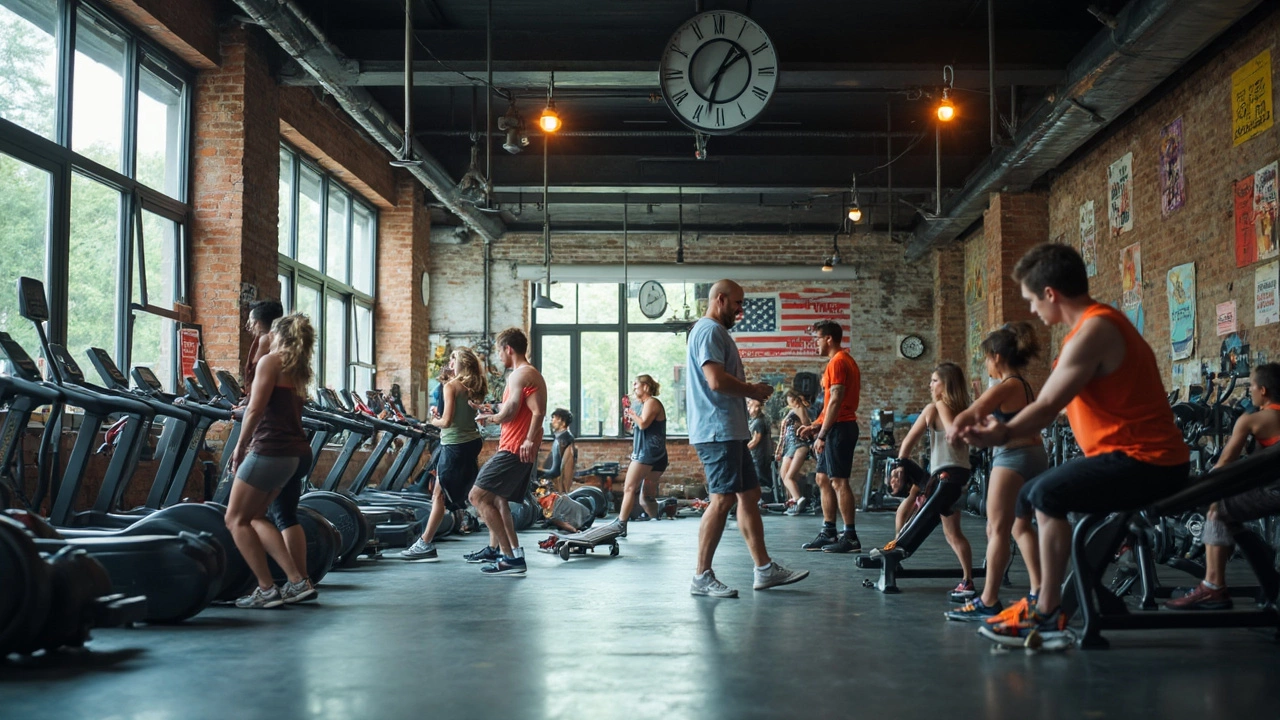Is 1 Hour at the Gym Enough for Results? Fitness Facts & Hacks
 Jun, 29 2025
Jun, 29 2025
Do you need to clock in two-hour marathons for your sweat sessions to count? Scroll through Instagram and you’d think you need to live in the gym to grow muscle or burn fat. Truth is, the real magic happens in less time than most think. Science and real-life results say an efficient workout, even just an hour, can get you stronger, leaner, and fitter. So, is one hour at the gym enough? Let’s dig past the hype and see what actually works.
The Science Behind One Hour Workouts
The human body isn’t designed to be pushed non-stop for hours. In fact, research at the University of Copenhagen found that 30 to 60 minutes of daily exercise produced the same or sometimes better results than longer sessions when it comes to weight loss. Why? The answer is focus. When you know you’ve only got one hour, you tend to make every minute count. This isn’t just about burning calories, either. It’s about triggering the right processes in your muscles and metabolism.
Hormones play a big part. Your body releases testosterone and growth hormone during moderate to intense exercise – both peak around the 30 to 60-minute mark. Go over and you risk increasing cortisol, the stress hormone that can actually break down muscle if you linger too long. Also, unless you’re training for an ultra-marathon or powerlifting competition, there’s a point of diminishing returns after about an hour. Muscles get fatigued, form slips, and injury risk goes up. Studies published in the Journal of Physiology back this up, suggesting muscles are most responsive to anabolic signals in that first hour.
Most trainers I know swear by the ‘quality over quantity’ motto. Ask my daughter Quinn — she’s a stickler for efficiency, racing through schoolwork to carve out time for her favorite dance game. The same logic fits gym sessions: if you push hard, with tight rest periods and smart exercise choices, you can squeeze a lot out of 60 minutes. What matters is what you do with your time, not how long you put in.
How to Make Every Minute in the Gym Count
An hour at the gym can look wildly different based on your strategy. People fiddling with their phones, checking fantasy football scores, or waiting for the cable machine to open up barely break a sweat. That’s not efficient. Want to use an hour for the best return? Structure is your secret weapon.
I tell my kids this all the time: “Failing to plan is planning to fail.” Show up with a written plan. Know exactly which muscle groups you’ll target, how many sets and reps, and even what weights you used last time. You walk in, warm up for about 10 minutes (dynamic stretches, maybe a cardio spike), and jump right into the heavy hitters first when your energy is highest. Compound exercises – think squats, deadlifts, bench presses, pull-ups – give you the biggest bang for your buck. A full-body circuit can torch hundreds of calories and recruit almost every muscle group.
Keep the intensity up. Instead of long breaks, try 60-90 seconds rest between sets. Supersets (pairing two exercises back-to-back) save time and keep your heart rate pumping. By the time the hour’s up, you’ll have done more than most people do in twice that time. I’m not alone – coaches training athletes for pro sports often cap sessions at an hour, maxing out focus and effort. And don’t forget: stretching isn’t optional. Spend five to 10 minutes cooling down. It helps recovery, keeps your joints happy, and sets you up to crush your next workout.
Having an accountability buddy works wonders, too. I’ve found when Finley tags along, we move faster and encourage each other to stick to the plan. Try timing rest with a watch, or using the timer on basic apps. Anything that keeps you honest, focused, and moving with a purpose will dramatically up the value of that single hour.

Does Your Fitness Goal Change The Answer?
The sweet spot for gym time can shift depending on what you’re chasing. Trying to lose weight? One hour of intense, circuit-style resistance training or interval cardio is usually enough to burn a solid chunk of calories and fire up metabolism for hours after you leave. Building muscle? The best bodybuilders often structure their training into 60-minute sessions split by body part. The difference is in the intensity and how you split sets, not the clock.
Endurance athletes may need longer sessions, but even then, trainers usually only program one or two ‘long’ efforts per week to avoid burnout. For most regular folks, an hour fits perfectly with work, family, and life. The American College of Sports Medicine recommends 150 minutes of moderate or 75 minutes of vigorous physical activity per week. Spread this over the week and you’re looking at three to five gym visits, each around 45 to 60 minutes – nothing extreme.
Recovery is another deal-breaker. If your sessions regularly leave you dragging for days, that’s a red flag. Most people actually need more intensity and less volume – not more exhaustion. I’ve seen my own progress jump when I swapped endless accessory lifts for focused, heavy sets with tight form, finishing up with core or cardio finishers to get the heart rate up. Not only does this change make it easier to recover, but it also frees up more time for family and, let’s be honest, for Netflix binges later on.
What the Data and Coaches Say
Let’s go past the inspiration quotes and dig out some hard numbers. A 2016 study published in the Journal of Sports Sciences tracked two groups doing strength training. One group trained for 30 minutes, the other for 60. Both gained similar muscle over eight weeks, though the hour group had slightly better strength gains. The catch? The difference wasn’t mind-blowing, and both groups reported similar satisfaction.
Move over to the HIIT crowd, where 20-30 minute sessions rule. HIIT torches as many calories in half the time as moderate-paced cardio – confirmed by a meta-analysis in the British Journal of Sports Medicine. Still, most people evenly split their gym routines between strength, mobility, and some form of cardio, and an hour gives you enough room for all three. Pro coaches in the NFL, NBA, and soccer tend to wrap up practice and gym blocks in 60 to 75 minutes, focusing on keeping intensity sky-high. Nobody is grinding away for three hours unless they’re prepping for the Olympics or Tour de France.
Many personal trainers set hourly appointment blocks, and for a good reason. They want you in, working hard, and out before performance drops. You might hear stories of celebs or influencers spending three hours “on set,” but subtract the selfies and chatter, and that’s a normal workout plus some stretching and foam rolling. The truth? You’re not missing some secret sauce by wrapping it up under 90 minutes. In fact, sticking with a 1 hour gym routine means you’re way less likely to skip sessions because you can fit it into a real life.

Real World Tricks for Squeezing More Out of an Hour
Efficiency turns a regular hour at the gym into a productivity engine. First, prioritize. Start with what matters most for your goals (heavy lifts, intervals, whatever your main focus). Don’t get lost in Instagram-lurking or waiting for a specific machine – have three backup moves ready. Devices like kettlebells, dumbbells, or bodyweight exercises can save the day if the gym’s slammed.
Create a playlist that keeps you pumped and on track. Music not only boosts mood but can actually bring out more effort, according to a study out of Brunel University. Another pro tip: train during off-peak hours if you can. There’s nothing like not having to chase down a bench to keep you from wasting time. Invest in a basic fitness tracker or stopwatch app – set it up to track your sets, rests, and session length. Not techy? Pen and paper works just as well.
Mix up your routine every few weeks to keep your body guessing and prevent plateaus. Swap dumbbells for kettlebells, switch up your rep schemes, or try circuit training. I’ll even let my kids “program” workouts for me sometimes – it usually means extra burpees and weird plank holds, but hey, variety keeps it interesting. Keep water close, save the texting for after, and you’ll be amazed what you can do in 60 focused minutes. Remember, the most important thing is consistency. A solid hour, repeated week after week, beats sporadic marathon sessions every time.